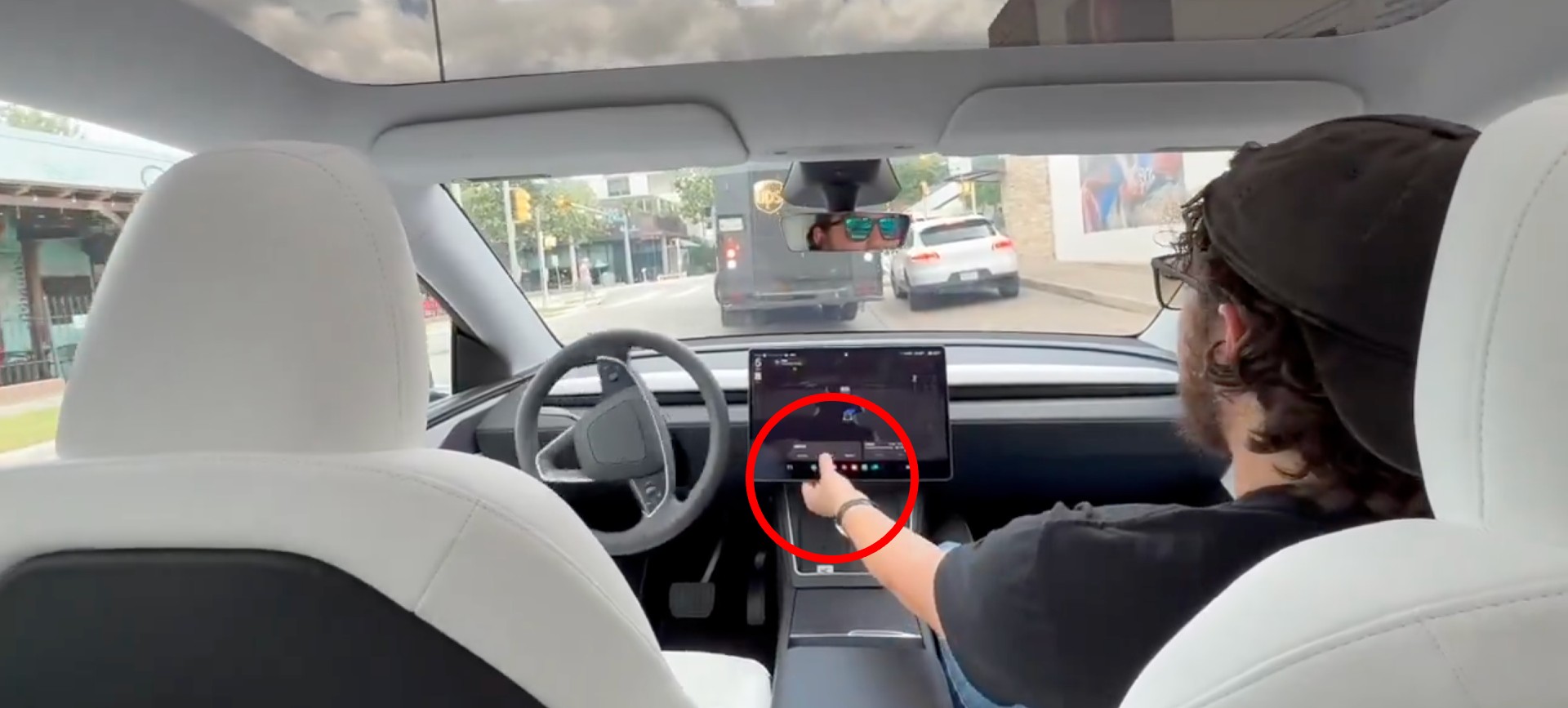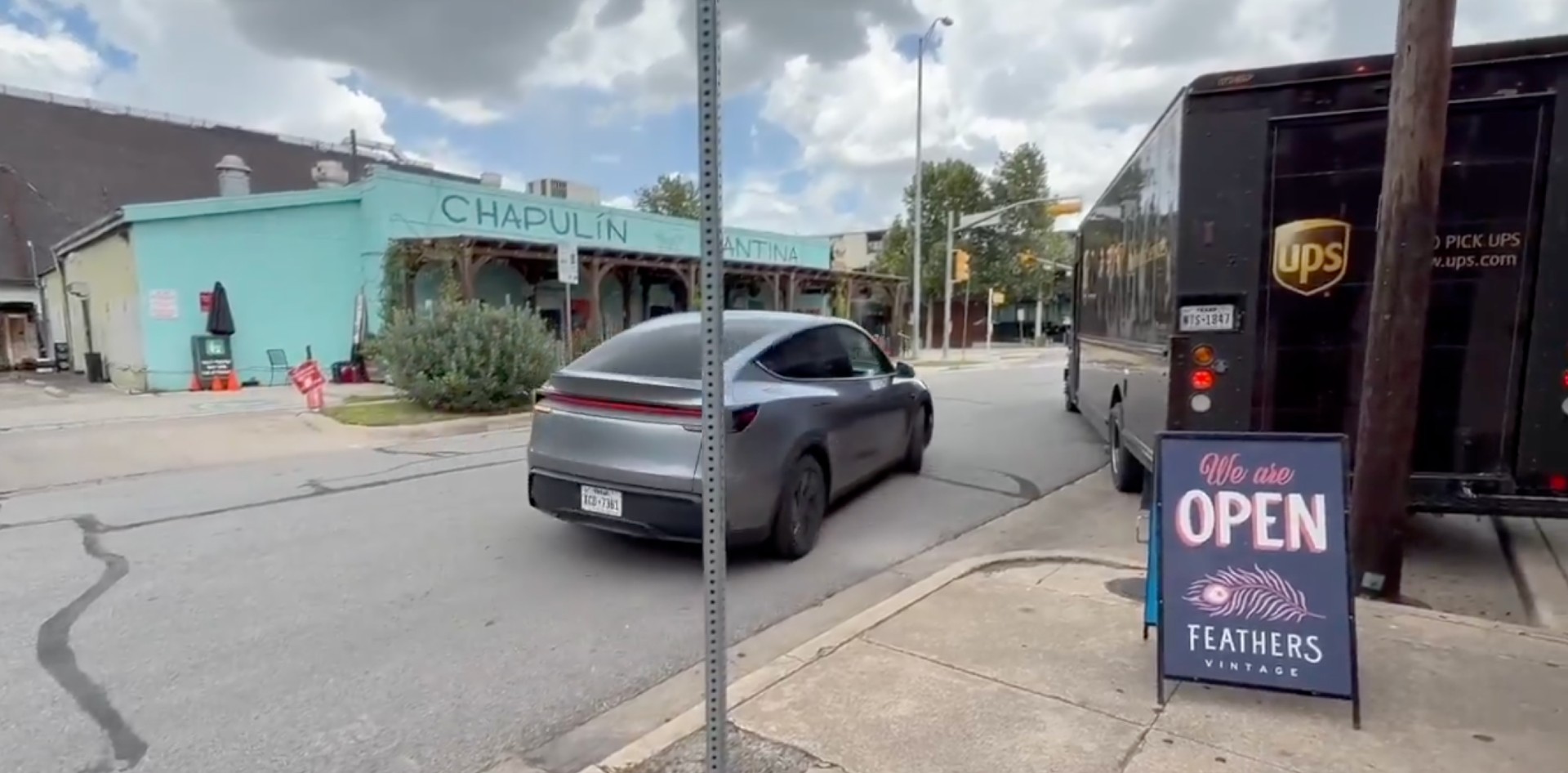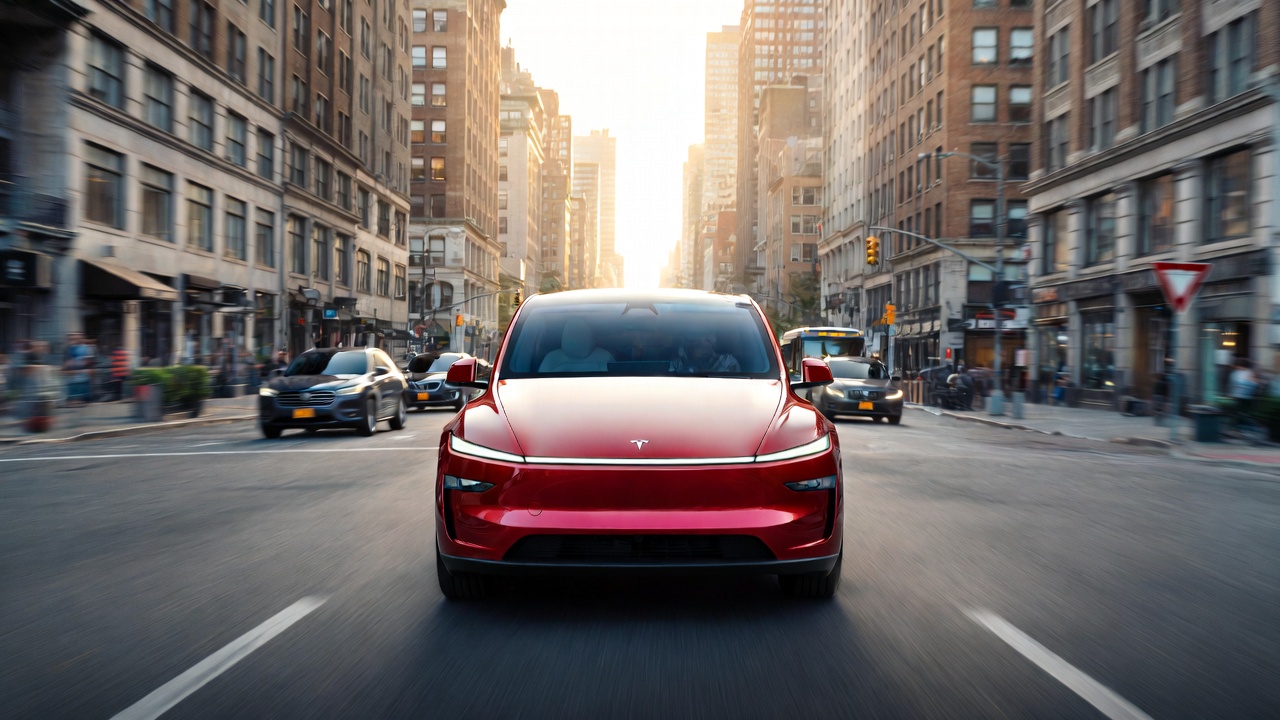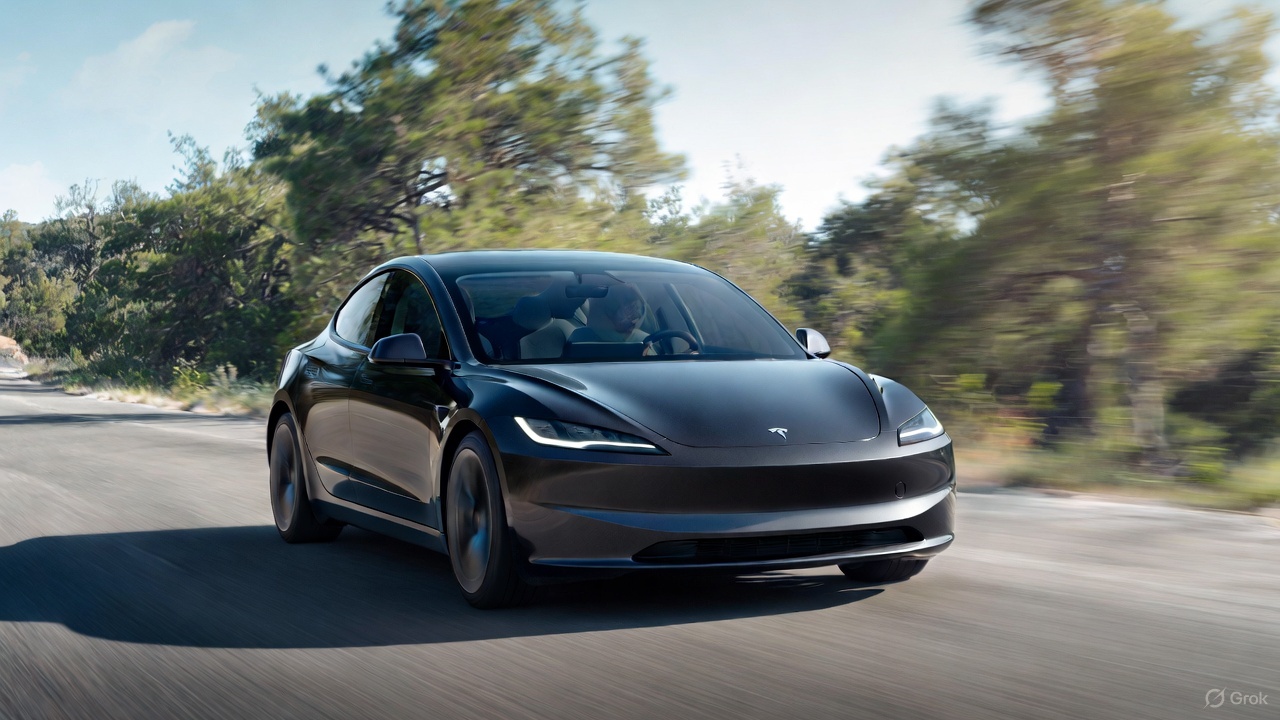News
Watch the first true Tesla Robotaxi intervention by safety monitor
Watch the first Tesla Robotaxi intervention by a safety monitor.

Nearly 60 hours into the launch of the Tesla Robotaxi platform, it appears we have our first true intervention that required the in-car safety monitor to intervene.
We’ve seen and heard about a handful of minor issues with the Robotaxi fleet thus far, one of which included a risky, but very human-like behavior of navigating across yellow lines to a turn lane after missing a turn.
While that is not necessarily a legal maneuver, it is something that you’d see commonly from human drivers, and although aggressive, it is sometimes reasonable to perform depending on traffic conditions.
For what it’s worth, the car seemed very confused by the situation, and while the safety monitor did not get involved and the car handled the situation with no real issue, it is something as a rider you’d like to see less of.
First Look at Tesla’s Robotaxi App: features, design, and more
As previously stated, that specific example did not require any intervention by a safety monitor. On Tuesday, we saw a video of the first true intervention that required the safety monitor who sits in the passenger seat to intervene by pressing a button on the center touchscreen.
During a ride that Tesla investor and YouTuber Dave Lee was taking in Austin in a Robotaxi, the vehicle seemed to get a little confused by a UPS truck that was parallel parking in front of it. The monitor pressed the “Stop in Lane” button on the touchscreen:
This is the first intervention we’ve seen with Robotaxi (via @heydave7): https://t.co/5mp431Z5P8 pic.twitter.com/B9ji3iLa3a
— TESLARATI (@Teslarati) June 24, 2025
This appears to be one of the first errors shared by Tesla Robotaxi Early Access Program users that required the monitor to actually intervene. We have not seen any of it yet. You could also see the UPS truck is also a bit at fault here, as the space it pulled into did not seem even remotely large enough to fit the entire vehicle.
The car may not have anticipated that the truck would park there. You can see how the UPS truck was parked below, and it seems reasonable that the Tesla might not have thought it would attempt to fit there:

Credit: Dave Lee
The Model Y’s steering wheel was also turning sharply right into this spot, it appears. Dave ended his ride here, and stated that this was his dropoff spot. The UPS truck might have just cut off the Tesla, which led to the intervention.
It is a testament to Tesla’s strategy with this Robotaxi rollout. The company is obviously confident enough in the Full Self-Driving suite that it does not feel a human needs to be in the driver’s seat. However, it is still requiring someone, as of now, to sit in the passenger’s seat for instances just like this one.
Safety is the company’s priority with the launch of Robotaxi, and CEO Elon Musk has reiterated that. It is expected that we’d eventually see some kind of intervention that requires a monitor to step in. Everyone was safe.
Obviously, these things happen with autonomous vehicles. We’ve seen Waymos get stuck at intersections in very strange scenarios at times:
Waymo turned into oncoming traffic on the way to work.
It sat there confused for 45 seconds with its hazards on.
Then it proceeded to back up into oncoming traffic.
And they’re about to let these guys on the freeway 😂 pic.twitter.com/ZLRKx2loo1
— Jake Glaser | LA Multifamily (@LAMultiBroker) January 31, 2025
It is proof that autonomous tech is still in a growth phase and engineers are still learning about its capabilities. Tesla and other companies will learn from these rare cases and become better companies, and offer safer technologies because of it.

News
Tesla FSD fleet is nearing 7 billion total miles, including 2.5 billion city miles
As can be seen on Tesla’s official FSD webpage, vehicles equipped with the system have now navigated over 6.99 billion miles.

Tesla’s Full Self-Driving (Supervised) fleet is closing in on almost 7 billion total miles driven, as per data posted by the company on its official FSD webpage.
These figures hint at the massive scale of data fueling Tesla’s rapid FSD improvements, which have been quite notable as of late.
FSD mileage milestones
As can be seen on Tesla’s official FSD webpage, vehicles equipped with the system have now navigated over 6.99 billion miles. Tesla owner and avid FSD tester Whole Mars Catalog also shared a screenshot indicating that from the nearly 7 billion miles traveled by the FSD fleet, more than 2.5 billion miles were driven inside cities.
City miles are particularly valuable for complex urban scenarios like unprotected turns, pedestrian interactions, and traffic lights. This is also the difference-maker for FSD, as only complex solutions, such as Waymo’s self-driving taxis, operate similarly on inner-city streets. And even then, incidents such as the San Francisco blackouts have proven challenging for sensor-rich vehicles like Waymos.
Tesla’s data edge
Tesla has a number of advantages in the autonomous vehicle sector, one of which is the size of its fleet and the number of vehicles training FSD on real-world roads. Tesla’s nearly 7 billion FSD miles then allow the company to roll out updates that make its vehicles behave like they are being driven by experienced drivers, even if they are operating on their own.
So notable are Tesla’s improvements to FSD that NVIDIA Director of Robotics Jim Fan, after experiencing FSD v14, noted that the system is the first AI that passes what he described as a “Physical Turing Test.”
“Despite knowing exactly how robot learning works, I still find it magical watching the steering wheel turn by itself. First it feels surreal, next it becomes routine. Then, like the smartphone, taking it away actively hurts. This is how humanity gets rewired and glued to god-like technologies,” Fan wrote in a post on X.
News
Tesla starts showing how FSD will change lives in Europe
Local officials tested the system on narrow country roads and were impressed by FSD’s smooth, human-like driving, with some calling the service a game-changer for everyday life in areas that are far from urban centers.

Tesla has launched Europe’s first public shuttle service using Full Self-Driving (Supervised) in the rural Eifelkreis Bitburg-Prüm region of Germany, demonstrating how the technology can restore independence and mobility for people who struggle with limited transport options.
Local officials tested the system on narrow country roads and were impressed by FSD’s smooth, human-like driving, with some calling the service a game-changer for everyday life in areas that are far from urban centers.
Officials see real impact on rural residents
Arzfeld Mayor Johannes Kuhl and District Administrator Andreas Kruppert personally tested the Tesla shuttle service. This allowed them to see just how well FSD navigated winding lanes and rural roads confidently. Kruppert said, “Autonomous driving sounds like science fiction to many, but we simply see here that it works totally well in rural regions too.” Kuhl, for his part, also noted that FSD “feels like a very experienced driver.”
The pilot complements the area’s “Citizen Bus” program, which provides on-demand rides for elderly residents who can no longer drive themselves. Tesla Europe shared a video of a demonstration of the service, highlighting how FSD gives people their freedom back, even in places where public transport is not as prevalent.
What the Ministry for Economic Affairs and Transport says
Rhineland-Palatinate’s Minister Daniela Schmitt supported the project, praising the collaboration that made this “first of its kind in Europe” possible. As per the ministry, the rural rollout for the service shows FSD’s potential beyond major cities, and it delivers tangible benefits like grocery runs, doctor visits, and social connections for isolated residents.
“Reliable and flexible mobility is especially vital in rural areas. With the launch of a shuttle service using self-driving vehicles (FSD supervised) by Tesla in the Eifelkreis Bitburg-Prüm, an innovative pilot project is now getting underway that complements local community bus services. It is the first project of its kind in Europe.
“The result is a real gain for rural mobility: greater accessibility, more flexibility and tangible benefits for everyday life. A strong signal for innovation, cooperation and future-oriented mobility beyond urban centers,” the ministry wrote in a LinkedIn post.
News
Tesla China quietly posts Robotaxi-related job listing
Tesla China is currently seeking a Low Voltage Electrical Engineer to work on circuit board design for the company’s autonomous vehicles.

Tesla has posted a new job listing in Shanghai explicitly tied to its Robotaxi program, fueling speculation that the company is preparing to launch its dedicated autonomous ride-hailing service in China.
As noted in the listing, Tesla China is currently seeking a Low Voltage Electrical Engineer to work on circuit board design for the company’s autonomous vehicles.
Robotaxi-specific role
The listing, which was shared on social media platform X by industry watcher @tslaming, suggested that Tesla China is looking to fill the role urgently. The job listing itself specifically mentions that the person hired for the role will be working on the Low Voltage Hardware team, which would design the circuit boards that would serve as the nervous system of the Robotaxi.
Key tasks for the role, as indicated in the job listing, include collaboration with PCB layout, firmware, mechanical, program management, and validation teams, among other responsibilities. The role is based in Shanghai.
China Robotaxi launch
China represents a massive potential market for robotaxis, with its dense urban centers and supportive policies in select cities. Tesla has limited permission to roll out FSD in the country, though despite this, its vehicles have been hailed as among the best in the market when it comes to autonomous features. So far, at least, it appears that China supports Tesla’s FSD and Robotaxi rollout.
This was hinted at in November, when Tesla brought the Cybercab to the 8th China International Import Expo (CIIE) in Shanghai, marking the first time that the autonomous two-seater was brought to the Asia-Pacific region. The vehicle, despite not having a release date in China, received a significant amount of interest among the event’s attendees.








